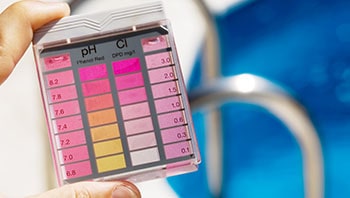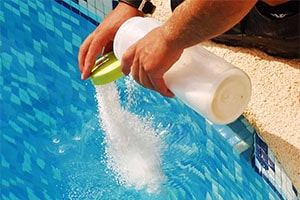Want some money-saving swimming pool tips? Our 2022 article is chock full of them!
Owning a pool can get expensive.
That’s why you should use every strategy you can to save money. Here are a few cost-cutting tips to keep costs down:

1. Winterize Your Pool Yourself
The average cost of having a professional winterize your pool is $250.
You can either pay this amount or save a few bucks and do it yourself. Here’s what you need to do if you choose the latter option:
Pool Closing Steps

Remove Debris
Vacuum the pool to remove all debris. Use a soft brush along the pool’s sides and floor to remove any algae growth or dirt. If you have a vinyl liner, be careful not to scratch or tear it.
You can have a robot pool cleaner do this for you.
You’ll also need to skim the surface of the water and clean out the skimmer and baskets.
Lower Your Water Level
Use your filter pump to lower your pool water level. You’ll need to reduce the level about four to six inches below the lowest plumbing line.
Ensure the water level is below the skimmer. Drain the water out of your pump, filter, heater, and chlorinator. Add a bit of marine antifreeze to the lines to prevent any cracking.
Clean Your Filter
You’ll need to backwash sand and diatomaceous earth (DE) filters. After doing this, disconnect them and store them in a dry place.
Thoroughly clean cartridge filters and let them dry. If the filter is small, take it apart and store it.

Test the Pool Water
Purchase a test kit and test your pool water before closing it for the season.
This means ensuring that you balance the alkalinity, pH, and other levels before putting on your pool cover.
Treat the Pool Water
It’s an excellent idea to shock and chlorinate the water a few days before closing the pool.
Also, you’ll want to run your pool’s pump through an entire cycle before you backwash it and chemically treat the filter.
Install A Cover
To finish the winterizing process, you’ll need to install a cover.

You can choose a cover that only blocks debris. Or, you can buy one that protects pets and people from falling in. Whichever one you pick, get one that fits your pool like a glove and is long-lasting.
A solar cover (AKA solar blanket) attracts heat from the sun, keeps heat in, keeps debris out, and helps prevent water from evaporating.
All of this can save you hundreds of dollars over a year.
2. Keep Your Pool Cover Clean

To prolong the life of your pool cover, use a pool cover pump to keep the rain and snowmelt off it.
When spring rolls around, you’ll be thankful that you went through the trouble of keeping the cover clean from rain and debris. It’ll be ten times easier to remove, and you’ll be able to re-use your cover the following winter.
The costs of buying a brand-new pool cover every year add up after a while.
When the cover is dry, take out your broom and sweep leaves and other debris off it.
3. Store Your Vacuum Heads Correctly
The biggest reason why people need to replace their vacuum heads is because the brushes have either fallen off or have been flattened out due to improper placement.
That’s why it’s crucial to store your vacuum head upside down and out of the sun’s relentless rays.
Over the winter, keep it out of the chlorine. If you do both these things, you’ll double the life of your vacuum heads.
4. Use Baking Soda to Raise Alkalinity

Pool chemicals can be expensive to buy. However, you can purchase a less expensive alternative for one of them at your local Kroeger’s.
I’m talking about substituting baking soda for commercial alkalinity increaser. By making this simple switch, you’ll save yourself a little money.
You might be afraid that using baking soda means you’ll end up doing a lot of complicated mathematical calculations to get the proportions right. However, that won’t be the case. Baking soda has the same concentration of sodium bicarbonate as what you’d buy at your neighborhood pool store.
Keep in mind that baking soda has more powder in it than the commercial stuff. This might cause your pool to cloud up. To prevent this problem, try adding small amounts at first.
5. Run Your Pump Less in Mild Climates

If you live in a hot climate, you’ll need to run your pump 10 to 12 hours during the warmest months to cut down on algae growth.
However, if you live in a mild climate, you can get away with running your pump six hours a day. Or getting a variable-speed pump that uses less energy.
6. Take Advantage of Spring Specials
Many pool stores run spring specials. These are often chemicals left over from the previous season the proprietor is trying to sell to make way for this year’s shipment.
You can get a jumpstart on summer by taking advantage of these deep discounts.
7. Run Your Pump at Night
During the week, 7:00 AM to 7:00 PM are peak hours for most electric companies in America. This is when electricity is most expensive.
To save money, run your pump during off-peak hours.
8. Watch Chlorine Stabilizer Levels

Chlorine stabilizer is also called cyanuric acid.
It’s a chemical that prevents the sun from breaking down the chlorine you put in your pool. When you add chlorine to your pool with shock or chlorine tablets, the chlorine isn’t stable.
This means that it’ll break down fast in the water.
Chlorine stabilizer helps chlorine to stay stable. This ensures that chlorine will stick around long enough in your water to disinfect it.
9. Conserve Pool Water
The average uncovered pool loses about an inch of water a week. That’s 7,000 gallons a year!
Pools waste water in four ways:
- leaks
- splashing out
- filter backwashing
- evaporation
While the water lost at any given moment might seem insignificant, it can add up to thousands of wasted gallons every year.
This can cost you hundreds of dollars.

Evaporation is probably the most significant way pools lose water. To fight this insidious phenomenon, ensure your pool is covered when not in use. A simple solar cover between swims can dramatically cut down on evaporation.
Keep pool heaters at the lowest possible settings to reduce the number of water molecules vanishing into the atmosphere.
Wind moving across the water’s surface can increase evaporation. You can cut down on the amount of wind blowing over your pool with strategically placed shrubbery, fences, or boulders.
10. Protect Your Equipment
Keeping your filters, skimmer nets, and pool brushes in a secure place in the garage or in a shed can help maintain equipment in mint condition as long as possible.
If you notice that your heater systems and pool pumps have cracks or leaks, have a technician repair them ASAP.

11. Switch to LED Lights
LED lights can last up to two decades and are incredibly energy efficient.
They also come in a dizzying variety of fun colors, which means you can add a chic new look to your pool while cutting down on electricity costs.
Final Thoughts
There’s no getting around it—owning a pool isn’t cheap.
However, following the strategies in this article can save you lots of money. That’s always a great feeling, which enhances the enjoyment that comes with pool ownership.
If you want to see what are picks for the best automatic pool cleaners of 2022 are, check out our comprehensive guide.
Which strategy did you like the most?
Let me know in the comments!

Pool Maintenance Tips & Tricks




Adding lights to pool is really a small yet amazing update. As you mentioned is adds a chic look to it. Also, the tip about using pool covers is a great one, not many people focus on it but they should.